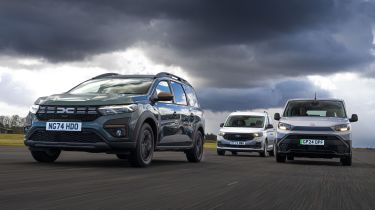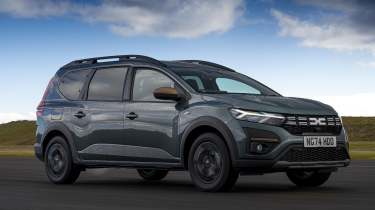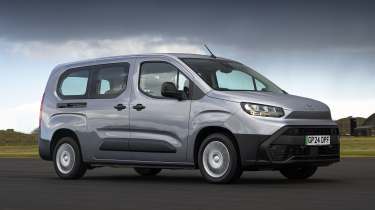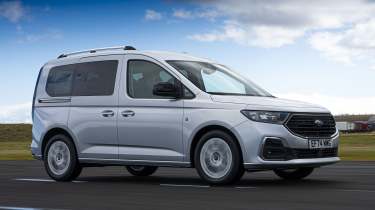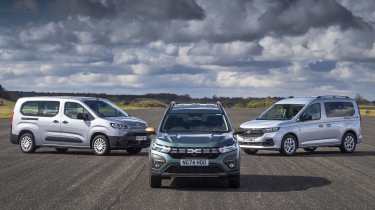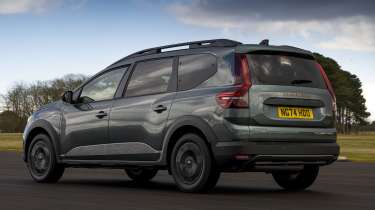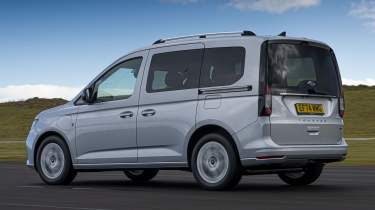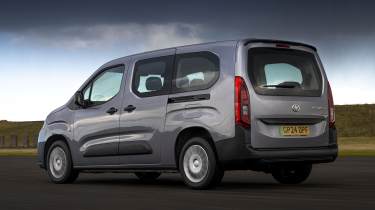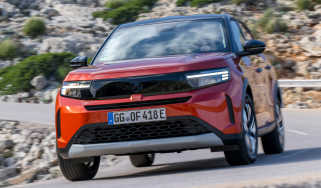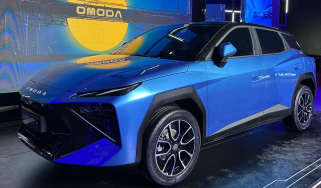Dacia Jogger vs Ford Tourneo Connect vs Toyota Proace City Verso: 7-seat family MPVs put to the test
We put hybrid, PHEV and electric MPVs from Dacia, Toyota and Ford to the test to discover which makes the best seven-seat family car
In the realm of seven-seat family cars, there are two extremes to choose from. At the top end of the market are plush SUVs and MPVs, some powered by petrol, some plug-in hybrid and others fully electric, while at the budget end, there is a selection of van-based models to choose from.
However, one car that bucks the formula is the Dacia Jogger. Mixing supermini and estate car DNA together has created an interesting alternative to the multi-seat family car norm. But how does the Jogger compare with the more conventional van-based MPV? To find out, we’ve lined up two models that will be a stern test for the Romanian family wagon.
The Toyota Proace City Verso has a tongue twister of a name and lots of interior space, while the Ford Tourneo Connect is even bigger in seven-seat guise. The question is whether the Jogger has the ability to overcome a relative lack of space compared with these two to justify its lower list price.
To further add to the mix, the Toyota is exclusively electric, while we’re testing the Ford in plug-in hybrid guise and the Dacia as a hybrid to see which makes the most sense for family duties.
Dacia Jogger
| Model: | Dacia Jogger 1.6 Hybrid Extreme |
| Price: | £18,970 |
| Powertrain: | 1.6-litre petrol hybrid, 2x electric-motors, 1.2kWh battery, 138bhp |
| 0-62mph: | 10.1 seconds |
| Test efficiency: | 50.2mpg |
| EV range: | N/A |
| Annual VED: | £195 |
The Dacia Jogger is a unique offering in the new-car market. Falling somewhere between a supermini and an estate car, it features plenty of tried-and-tested tech on board to keep costs down, making it the cheapest new seven-seater currently available.
Used - available now

2024 MG
MG4 EV
12,680 milesAutomaticElectric
Cash £16,900
2022 Renault
Captur
53,877 milesManualPetrol1.3L
Cash £13,100
2026 Volkswagen
Taigo
22,175 milesManualPetrol1.0L
Cash £15,000
2024 Volkswagen
Taigo
29,350 milesManualPetrol1.0L
Cash £14,500We’ve used the top-spec Extreme model for our pictures, and for a mix of power sources we’ve lined up the Hybrid version. We want to see how it compares with its plug-in and all-electric rivals as everyday fuel-saving practical transport.
Tester’s notes
One appealing aspect of the Jogger is that it’s only as wide as a Dacia Sandero from behind the wheel, so feels like a supermini to drive. Some people might be more intimidated by larger van-derived people carriers because of their dimensions and boxy proportions, but with the Dacia there aren’t any issues like that to worry about.
This means the Jogger demands some compromises in terms of outright carrying capacity, but that is something many will put up with for a car that’s more manageable to drive.
Although the Jogger is built down to a budget, there are additions to the cabin that help it feel more upmarket than its low prices suggest. We particularly like the neoprene-style fabric inserts that are added to the seats, door armrests and dashtop of the Extreme model.
It’s more interesting to the touch than regular fabric, and the wetsuit feel ties in with the lifestyle angle the top-spec model caters for. The surface is wipe-clean, too, which should make it useful for family life.
Toyota Proace City Verso
| Model: | Toyota Proace City Verso 50kWh Icon Long |
| Price: | £31,995 |
| Powertrain: | 1x electric motor, 50kWh battery, 134bhp |
| 0-62mph: | 11.2 seconds |
| Test efficiency: | 3.1 miles/kWh |
| EV range: | 213 miles |
| Annual VED: | £195 |
The Verso badge has been used by Toyota on a number of MPV-style vehicles in the past – anyone remember the Yaris Verso? Today it’s worn by passenger versions of the Proace and Proace City vans.
These models share their tech with the Stellantis group of brands, although Toyota is still a relatively small player in the commercial vehicle market in the UK. The range has been subject to a facelift in line with the Stellantis versions, and this includes upgraded battery technology.
Tester’s notes
There was once a time that saying a vehicle ‘drove like a van’ came with some negative undertones. However, the current crop of van-based MPVs share plenty with their passenger-carrying brethren.
The Stellantis-sourced platform that the Toyota Proace City Verso Electric sits on is a conversion of the EMP2 architecture that was used by cars such as the last Peugeot 308 and Citroen C5 Aircross, and nobody could accuse either of those models of lacking in comfort or refinement.
In the past, van-based MPVs have been as basic as they come, with the same hard floors and wipe-down surfaces found in their commercial counterparts, where such materials are fitted in the name of hard-wearing practicality.
However, there are more concessions to luxury on the Proace City Verso to help the Toyota fill the void left by traditional MPVs, with carpets used throughout and higher-grade fabrics fitted in important places.
Ford Tourneo Connect
| Model: | Ford Tourneo Connect 1.5 PHEV Grand Titanium |
| Price: | £34,500 |
| Powertrain: | 1.5-litre turbo petrol, 1x electric motor, 25.7kWh battery, 148bhp |
| 0-62mph: | TBC |
| Test efficiency: | 51.4mpg |
| EV range: | 71 miles |
| Annual VED: | £195 |
As with the Proace City Verso, the Ford Tourneo Connect benefits from technology sharing, in this instance with the Volkswagen Caddy. It’s part of a larger tie-up between Ford and Volkswagen that has also brought us the Ford Ranger and Volkswagen Amarok pick-ups, as well as the Ford Transit Custom and Volkswagen Transporter vans.
Here the Tourneo Connect features lots of VW-sourced running gear under the skin and technology in the cabin. The question is whether it can deliver a good compromise between its rivals in PHEV guise?
Tester’s notes
The Ford Tourneo Connect provides a very fuss-free driving experience, and it handles pretty well for a family MPV. It’s based on the same platform as the Ford Puma SUV, so it has some Ford Fiesta DNA in there.
However, if you’re looking for a bit more fun from a practical wagon, then the Ford Tourneo Courier could be for you, and it’s an even more engaging model than the Connect. The Tourneo Courier is slightly smaller and is only available with a five-seat layout, though.
Being a boxy van-based MPV means that the Ford Tourneo Connect can’t really get away from a design that prioritises function over form. However, Active trim does at least try and spice things up a bit by adding some off road-inspired styling.
As with Active versions of the Fiesta, Focus and larger Transit Custom, the rugged additions and diamond-cut alloys play to the utilitarian nature of the Tourneo, making a highlight of it and giving the car an ‘outdoors adventure’ character.
Head-to-head
On the road
Somewhat surprisingly, it was the Toyota that delivered the most pleasurable driving experience. None of these cars is designed to be thrashed, and when taking things easy it was the settled ride and quiet refinement of the Verso that led the way. The Dacia was still pretty good, though, while the Ford was at its best when there was some charge in the hybrid system’s battery that helped to smooth out its power delivery.
Tech highlights
While Dacia makes a play on its simplicity, the Jogger in Extreme trim is actually very well equipped, with a kit list that largely matches that of the more costly Ford – and with a more user-friendly infotainment system. The only glaring omission from the Tourneo Connect is heated seats (a £180 option), but both models show the Toyota the way, because the Verso has a van-like level of standard kit without much luxury.
Price and running
Low list prices are a big draw for the Jogger, while the Hybrid version backs them up with fuel economy in the 50mpg range on test. The Ford’s PHEV powertrain needs to be charged to get the best fuel economy, otherwise you’re just lugging extra weight for no benefit. In the Toyota, the range is limited by the 50kWh battery, especially in cold weather, because a heat pump is only available with the top-spec model.
Practicality
Van-derived MPVs still lead the way for outright carrying capacity. The Ford is slightly larger than the Toyota here, so it can transport that little bit extra, while the sliding doors boost access in tight spots. Space in the rearmost seats is good, too. The Jogger, in comparison, is compromised a little, both for access and overall space, but if you take out the back seats, you’re left with a roomy five-seat family wagon.
Safety
There’s a five-star Euro NCAP rating for the Ford, and it leads the way for safety kit, which includes adaptive cruise and blind-spot monitoring. The Toyota earned a four-star score and has all of the essentials, but is short on some of the cutting-edge tech. While the Jogger received a one-star rating from the safety body, it’s not all bad news, with recent upgrades to its safety kit helping improve its safety credentials.
Ownership
All three cars have pretty ordinary warranty coverage as standard, but Dacia and Toyota offer extra cover if you book servicing at authorised dealers. For Dacia, its Zen package extends the car’s warranty by 12 months for up to seven years or 75,000 miles, whichever comes first. Toyota goes even further with its warranty coverage, with owners able to take advantage of 10 years or 100,000 miles of cover.
Verdict
Winner: Dacia Jogger
It doesn’t quite have the versatility of its rivals here, because access to the rearmost seats is tricky and the space on offer is limited, but when you factor in the sheer value for money that the Jogger offers, it has a distinct advantage.
The hybrid powertrain is easy to get along with, performs well and delivers great fuel economy, while the cabin is roomy and tough enough to take on the challenges of family life.
Runner-up: Ford Tourneo Connect
If you’re looking to make the switch to a spacious family car that includes some electrification, but aren’t quite ready to make the leap to an EV, then the Tourneo Connect makes a good case for itself in PHEV guise.
The big caveat is one that applies to all plug-in hybrids: it makes most sense if you can charge it regularly. This boosts the car’s everyday driveability, while there’s enough of a performance advantage over the rest of the Tourneo Connect range to make it our choice.
Latest Ford Tourneo Connect deals
Third: Toyota Proace City Verso
The electric Proace City Verso is basic, but that means it offers no-nonsense urban transport that’s quiet, refined and can carry seven with ease. It’s smoother to drive than either rival here, while the folding seats are convenient for switching between cargo and passenger carrying.
The fact there are similar models from Citroen, Peugeot and Vauxhall doesn’t detract from the Toyota, because none of them can be had with a 10-year warranty.
Latest Toyota Proace City Verso deals
Prices and spec:
| Dacia Jogger | Toyota Proace City Verso | Ford Tourneo Connect | |
| Our choice | 1.6 Hybrid Extreme | 50kWh Icon Long | 1.5 PHEV Grand Titanium |
| Prices from/price of our choice | £18,970/£24,305 | £31,995/£33,245 | £34,500/£38,350 |
| Powertrain and performance | |||
| Powertrain | 4cyl/1,598cc, 1x e-motor | 1x e-motor | 4cyl/1,498cc, 1x e-motor |
| Power/torque | 138bhp/349Nm | 134bhp/270Nm | 302bhp/N/A |
| Transmission | Four-speed auto/fwd | Single-speed auto/fwd | Six-speed auto/fwd |
| 0-62mph/top speed | 10.1 seconds/104mph | 11.2 seconds/84mph | TBC/112mph |
| Fuel tank/battery capacity | 50 litres/1.2kWh | N/A/50kWh | 50 litres/25.7kWh |
| Official fuel economy | 57.6mpg | N/A | 589.6mpg |
| Official electric range | N/A | 213 miles | 71 miles |
| Test efficiency/range | 50.2mpg/552 miles | 3.1mi/kWh/155 miles | 51.4mpg/565 miles |
| Maximum charging | N/A | 100kW (0-80% in 30 mins) | 40kW (5-90% in 26 mins) |
| Dimensions | |||
| Length/wheelbase | 4,547/2,898mm | 4,751/2,975mm | 4,853/2,970mm |
| Width/height | 1,848/1,691mm | 1,848/1,812mm | 1,855/1,856mm |
| Middle knee/head/elbow room | 580-790/990/1,410mm | 595-825/1,065/1,535mm | 595-820/1,110/1,650mm+ |
| Rear headroom/elbow room | 690/895/1,240mm | 775/930/1,210mm | N/A+ |
| Boot space (7/5/2-seat mode) | 212/565*/2,085 litres | N/A/806/1,538 litres | 446/N/A/3,105 litres |
| Boot length/width | 885/1,160mm | 1,375/1,210mm | 970/1,180mm+ |
| Boot lip height | 635mm | 565mm | 560mm+ |
| Kerbweight/payload/towing weight | 1,385/610/750kg | 1,847/593kg/N/A | 1,858/702/1,400kg |
| Turning circle | 11.7 metres | 11.9 metres | 12.1 metres |
| Costs/ownership | |||
| Residual value (after 3yrs/36,000 miles) | £11,553/60.9% | £17,949/56.1% | £17,112/49.6% |
| Depreciation | £7,417 | £14,046 | £17,388 |
| Insurance group/quote/VED | 16/£842/£195 | 20/£986/£195 | 16/£594/£195 |
| Service cost | £504 for 3yrs [£13.99 x36] | £1,015 for 5yrs [£16.91 x 60] | TBC |
| Annual tax liability std/higher rate | £1,288/£2,577 | £199/£398 | £460/£920 |
| Annual fuel cost (12k miles) | £1,478 | £1,045 | £1,443 |
| Basic warranty (miles)/recovery | 3yrs (60,000)/3yrs | 3yrs (60,000)/1yr | 3yrs (60,000)/1yr |
| Driver Power manufacturer position | 22nd | 8th | 30th |
| NCAP Adult/child/ped./assist/stars | 70/69/41/39/1 (2021) | 91/81/58/68/4 (2018, expired) | 84/82/69/79/5 (2021) |
| Equipment | |||
| Metallic paint/wheel size | £650/16 inches | £680/16 inches | £180-£720/17 inches |
| Parking sensors/camera | Front & rear/rear | Rear/Design only | Front & rear/rear |
| Spare wheel/Isofix points | £300 (TCe only)/two | No/two | £300 (not PHEV)/two |
| Keyless entry & go/powered tailgate | Yes/no | Design only/no | Yes/no |
| Leather/heated seats | No/front | No/no | No/£180 pack |
| Screen size/digital dashboard | 8 inches/3.5 inches | 10 inches/10 inches | 10 inches/10.25 inches |
| Climate control/panoramic sunroof | Yes/no | Design only/no | No/Active only |
| USBs/wireless charging | Two/no | Two/no | Four/no |
| Wireless Apple CarPlay/Android Auto | Yes/yes (Extreme only) | Yes/yes | Yes/yes |
| Blind-spot warning/head-up display | Extreme only/no | No/no | Yes/no |
| Adaptive cruise/steering assist | Yes/yes | Yes/yes | Yes/yes |
What we would choose
Dacia Jogger: The Jogger comes with all the kit you need in top-spec trim. You can add a Sleep Pack (£1,815) that’s a box containing blackout blinds and a roll-out mattress, or the Plus version (£2,165) also throws in a tailgate tent.
Toyota Proace City Verso: If you want kit such as alloys, keyless entry and climate control, then your only option is to upgrade to Design trim. But this only comes as a five-seater, so you would have to weigh up if you can live without the seven-seat layout.
Ford Tourneo Connect: Heated front seats are available for a modest £180, or you can add ergonomic chairs with electric lumbar support for £720. If you don’t want a third row, it’s a no-cost option to turn the Grand Tourneo Connect into a five seater.
You can now buy a new car with Auto Express. Our nationwide dealer network has a choice of great cars on offer right now with new, used and leasing deals to choose from...

